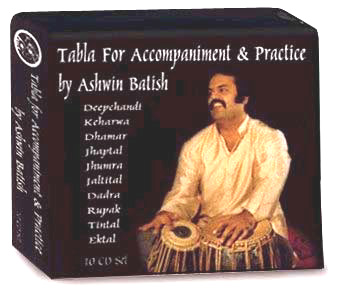
A publication of the Batish Institute of Indian Music and Fine Arts

A publication of the Batish Institute of
Indian Music and Fine Arts
Tabla Lesson 8 - Some Popular Tabla Thekasby Ashwin Batish 
About fifteen years ago, my father, Pandit Shiv Dayal Batish and I were sitting around and discussing how difficult it is to find a good tabla player to practice with. Sitting here in the West, in Santa Cruz, California, away from the buzy buzz of the larger cities where the probablity of finding other good caliber Indian musicians was a bit higher although at that time not by much. Also, my father was embarking on a large project encompassing around 2500 Carnatic ragas which he had started to practice and compose on. He needed some tracks to create and practice these compositions so he suggested why don't I record some thekas for this project and also have these available for the students at the Institute. I quickly fired up my recorders. It took over three months to record all the thekas. But we sat there are My father would sing songs and I would play a drum machine and note down the BPM for best tempos on each tala. Before long we had some really good recording of these thekas. We decided to give three tempos of the same theka Slow tempo (vilambit laya), Medium tempo (Madhya laya) and Fast tempo (drut laya). We chose 10 of the most popular thekas for the project.
These latter became the set whose image is shown above called Tabla for Accompaniment and Practice. We decided to sell this as a 32 casette or a 10 CD set. We have had a lot of requests to write down what I am playing on these thekas. This is a task that has taken me a while to get to for one reason or another. Bu I am trying to get this information into the magazine so that all the students that have purchased this set of tapes or CDs will have a better handle on the tabla bols played.
Slower tempos give you much more time and to avoid boredom it is usual for the tabla player to fill the space with some cleverly manipulated fills. But watchout, overdoing can lead to ex communication by th lead artist. Well, that's putting it mildly :) As the tempo increases, there is far less time for fills and so you start hearing the standard theka emerge. At a certain point, you'll only hear the basic theka as there is very little room to improvise. It takes a while before these fills sink in and sometimes it is best to listen to these again and again to get a handle on how they are squeezed into the playing. There are a few standard ones that you will hear every tabla player do. Then there are others that are typical of each tabla player's hands. In any case, to be good at these quick fills one has to attain a certain level of mastery of the tabla. So here are the ten basic thekas. Memorize them and them the next lesson, I'll present some theka variations called Theka Prakars.
|
|